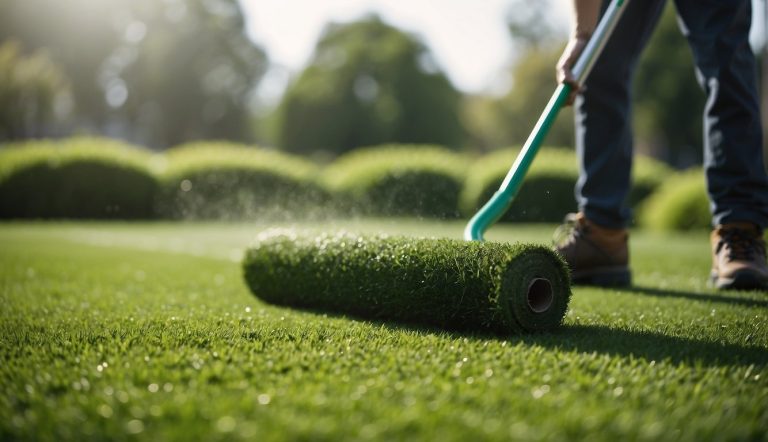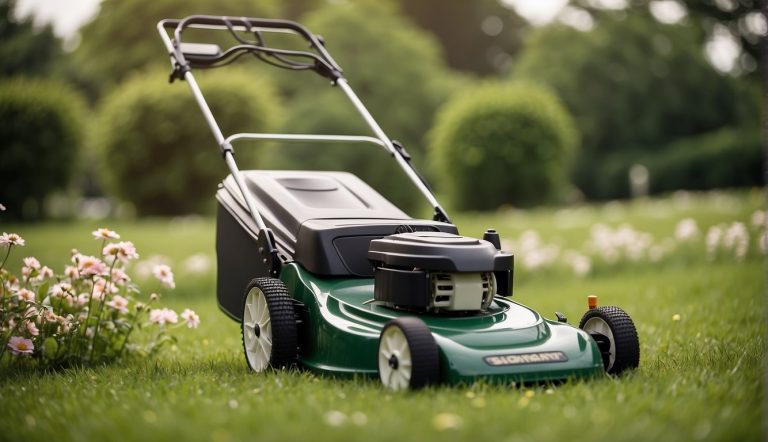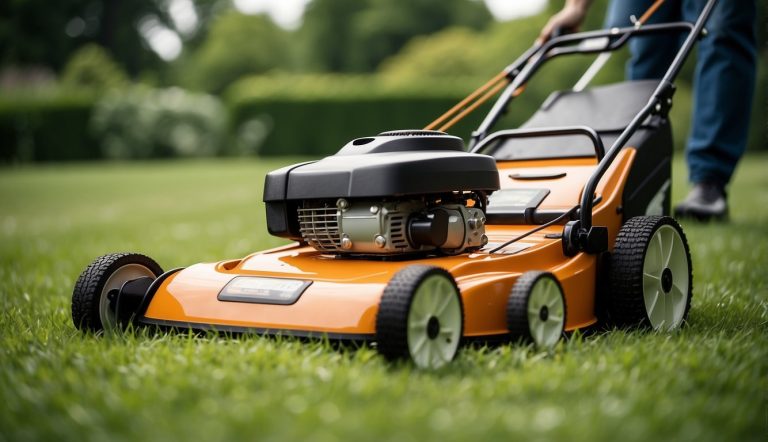How Often Should You Mow The Lawn? -Frequency Tips for a Healthy Turf
Deciding how often to mow your lawn is a crucial part of maintaining your yard’s appearance and health.
Every lawn is unique, and its ideal mowing frequency can be influenced by grass type, growth patterns, and the season.
As a general rule, it’s vital to cut grass often enough to maintain its ideal height without stressing the plant. Cutting too much at once can harm the grass, while not mowing often enough can lead to an overgrown and possibly thatch-prone lawn.

Adjusting the mowing schedule in response to changes in the grass growth rate is important. For example, during peak growing seasons, more frequent mowing might be necessary, while growth may slow down during dry or cold periods, requiring less frequent cuts.
Some ecological studies suggest that less frequent mowing can benefit local wildlife, such as bees, by allowing flowers more time to bloom. Whether maintaining a ‘perfect’ lawn or choosing a more natural approach, understanding the balance between aesthetic preferences and ecological impact is key.
Key Takeaways
- It’s essential to adjust mowing frequency to grass type and growth rate.
- Mowing too often or not enough can both have negative effects on lawn health.
- Ecological considerations can influence how often you decide to mow your lawn.
Understanding Your Lawn’s Needs
When it comes to lawn maintenance, recognizing the particular needs of your grass type and how different seasons affect these needs is essential. My goal is to help you grasp these aspects to foster a healthier lawn.
Grass Types and Their Growth Patterns
Cool Season Grasses: These include varieties such as Kentucky bluegrass, perennial ryegrass, and fescues. I’ve observed that they thrive in cooler temperatures, typically between 60 to 75°F. Their growth peaks in the spring and fall, and they often require more frequent mowing during these times to keep up with their rapid growth.
- Ideal Mowing Frequency: Every 3-5 days during peak growth periods.
Warm Season Grasses: Bermuda, Zoysia, and St. Augustine grasses are typical warm season varieties. They grow best when soil temperatures are between 70 to 90°F, usually hitting their stride in the late spring and summer.
- Ideal Mowing Frequency: Every 5-7 days during summer months.
It’s important to note that mowing too frequently can stress the grass, while too infrequently can stunt its natural growth pattern and health.
Influences of Seasons on Lawn Care
The changing seasons have a significant impact on lawn care routines. Here’s how I tailor my approach throughout the year:
Spring: Grass begins to wake up as the soil warms. This is when cool season grasses pick up their growth rate, and I start mowing more regularly.
Summer: Warm season grasses will be in full swing, but the heat can be tough on cool season types. Mowing may become less frequent to protect them from heat stress.
Fall: Cool season grasses experience another growth spurt. For me, this means returning to a more frequent mowing schedule to prepare the lawn for winter.
Winter: Growth slows down or stops. Mowing is not usually necessary during this period unless you’re in a particularly warm climate where warm season grasses may still show some growth.
Mowing Techniques for Healthy Grass
I find that paying attention to how I mow my lawn can greatly affect its health and appearance. Let’s explore some specific techniques that can help keep your grass vigorous.
Proper Mowing Height
Determining the proper mowing height for grass is crucial for lawn health. Each type of grass has a recommended height range. For example, cool-season grasses like Kentucky bluegrass thrive when cut to about 2.5 to 3.5 inches, while warm-season grasses, such as Bermuda, often do best between 1 and 2 inches.
Maintaining your grass within these ranges encourages deeper root growth and can help prevent weeds.
The One-Third Rule for Cutting Grass
To maintain lawn health, I always follow the one-third rule: never cut more than one-third of the grass blade length at a time.
This practice prevents stress on the grass and conserves its energy, leading to a thicker, more resilient turf. If my grass is at the ideal 3 inches, that means I should cut it before it reaches 4.5 inches tall.
Mower Blade Maintenance
Sharp lawn mower blades are essential for a clean cut. Dull blades tend to tear the grass rather than slicing it cleanly, which can result in a brownish tinge to your lawn due to the damaged grass tips.
I recommend checking and sharpening mower blades regularly—typically after every 20 to 25 hours of mowing time—to ensure they’re always ready for action.
Seasonal Lawn Care Schedule

When I approach lawn care, I pay special attention to the changing seasons as they dictate my mowing schedule. During peak growing seasons like spring and summer, lawns typically require more frequent mowing, while in fall and winter, the focus shifts toward lawn maintenance and preparation for dormancy.
Spring and Summer Mowing
In spring, I find that my lawn starts to wake up from its winter dormancy and quickly enters a period of vigorous growth. This is a time when mowing can become a more regular activity; I tend to mow my lawn approximately once a week.
I adjust my mower to cut the grass at about 2.5 to 3 inches, as taller grass supports root development and helps to crow out weeds.
Once summer arrives, the frequency of mowing depends on rainfall and temperatures. To help my lawn cope with the heightened stress from heat, I often mow less frequently and maintain grass height a bit higher, around 3 to 4 inches. I try to follow these rules:
- Mow when the grass is one-third taller than the desired height.
- Never remove more than one-third of the grass blade length in a single mowing session to avoid shocking the lawn.
Fall and Winter Lawn Management
As the season transitions to fall, grass growth slows, and so does the need for mowing. During this time, the mowing frequency diminishes gradually to once every two weeks, depending on the weather.
I continue to follow the one-third rule for cutting grass blades and prepare my lawn for winter by gradually reducing the cutting height of my mower in late fall.
In winter, lawns are usually dormant in colder climates, and mowing is typically unnecessary. It’s a good period for me to service my mower and prepare it for the spring ahead. But I always make sure to remove any fallen leaves and debris to keep the lawn clean; this prevents matting and disease.
Optimizing Lawn Health
To maintain a healthy lawn, I concentrate on regular lawn care practices, including proper watering, fertilizing, and tackling weeds and pests. These efforts are critical for sustaining a vibrant and resilient turf.
Watering and Fertilizing
Watering: I ensure my lawn receives an adequate amount of water, which typically means 1 to 1.5 inches per week, whether from rainfall or my watering system.
I water my lawn deeply and infrequently to encourage strong root growth, preferring the early morning to reduce evaporation and minimize disease risk.
- Ideal Watering Schedule:
- Early morning, 2-3 times a week
- Adjust according to weather conditions
Fertilizing: Providing my lawn with the right nutrients is essential for its health.
I apply a balanced fertilizer rich in nitrogen, phosphorus, and potassium during the growing season, according to the recommended schedule and amount for my specific grass type.
- Recommended Fertilizer Schedule:
- Early Spring: Balanced, slow-release fertilizer
- Mid-Summer: High-nitrogen fertilizer
- Fall: Winterizing fertilizer with higher potassium
Dealing With Weeds and Pests
Weeds: I maintain a diligent weeding schedule to prevent weeds from competing with my grass for nutrients and water.
I opt for manual removal or spot treatment with herbicides as needed, always following label instructions to avoid over-application.
- Weed Control Strategies:
- Regular manual removal
- Use of pre-emergent and post-emergent herbicides selectively
Pests and Diseases: I inspect my lawn regularly to identify signs of pest infestations or diseases early.
For pests like grubs or chinch bugs, I apply the appropriate control measures timely. For diseases, I focus on prevention through proper lawn care practices, and I use fungicides only when necessary.
- Pest and Disease Prevention:
- Regular monitoring for early detection
- Appropriate, timely treatments with insecticides or fungicides
Common Lawn Care Myths and Mistakes
When it comes to maintaining a healthy lawn, I’ve learned that there’s a lot of misinformation out there. Let’s clear up some common myths about frequent mowing and grass height to ensure your lawn stays in top shape.
The Truth About Frequent Mowing
It’s a common belief that frequent mowing is necessary to keep a lawn looking neat and healthy. However, constantly cutting your grass isn’t always the best approach.
Lawn care experts recommend mowing based on grass growth and health rather than on a strict schedule. Over-mowing can stress the grass, making it more susceptible to disease and drought.
Instead, I follow the one-third rule: never remove more than one-third of the grass blade in a single mowing. This helps maintain proper grass health and avoids putting unnecessary strain on the lawn.
Misconceptions About Grass Height and Health
Many people think that keeping grass cut short is the key to a manicured lawn. However, grass actually needs a certain height to perform well during extreme weather.
Short grass exposes the soil to the sun, which can lead to drying and increases the need for watering during drought conditions. I’ve found that a grass height of about 2.5 to 3 inches is optimal for most lawns.
This height helps to develop deeper roots and retain soil moisture, which in turn reduces the need for frequent watering. So, by letting your grass grow a bit taller, you’re promoting a healthier and more drought-tolerant lawn. Remember, improper mowing – too short or too frequent – can do more harm than good.
Frequently Asked Questions
In my experience, the right mowing frequency can make a significant difference in the health and appearance of your lawn. Let’s look at some common questions on the topic.
What is the ideal frequency for mowing a lawn in summer months?
During the summer, I recommend mowing your lawn about once a week. This is due to the faster growth rates seen in warm weather.
Can mowing your lawn too often cause damage to the grass?
Yes, mowing too frequently can stress the grass, potentially leading to a weakened lawn that’s more susceptible to pests and diseases.
During winter, how often should lawn mowing be scheduled?
If your grass continues to grow in winter, I suggest reducing the mowing frequency to once every two weeks or as needed, depending on the growth rate and climate conditions.
Does more frequent lawn mowing contribute to a thicker lawn?
Regular mowing, when done correctly, can encourage a dense, healthy lawn. However, mowing too often can have the opposite effect.
In what situations is it acceptable to leave grass clippings on the lawn after mowing?
Leaving clippings on the lawn, a practice known as grasscycling, is okay if they’re short, as they can decompose quickly and return valuable nutrients back to the soil.
How does lawn mowing frequency vary with different seasons, like spring and fall?
In spring, I increase the mowing frequency as the grass growth accelerates. In fall, the frequency decreases gradually as the growth begins to slow down.







